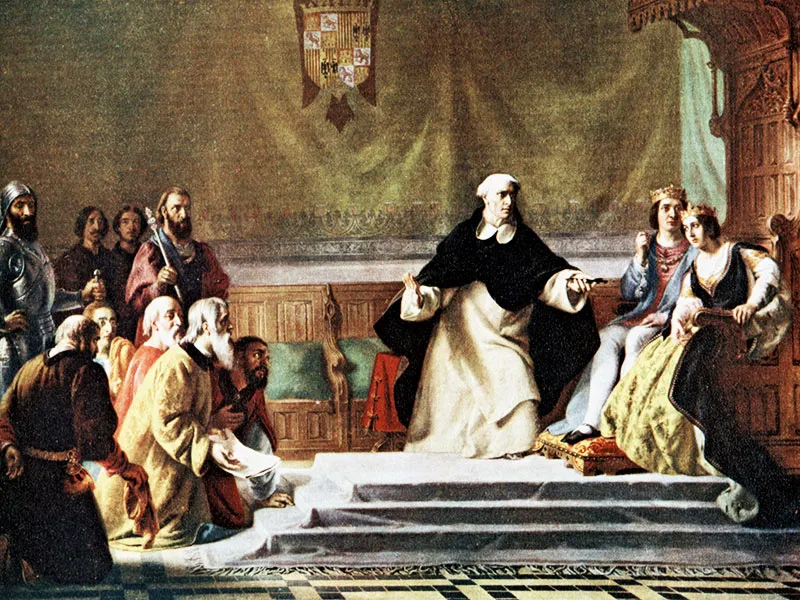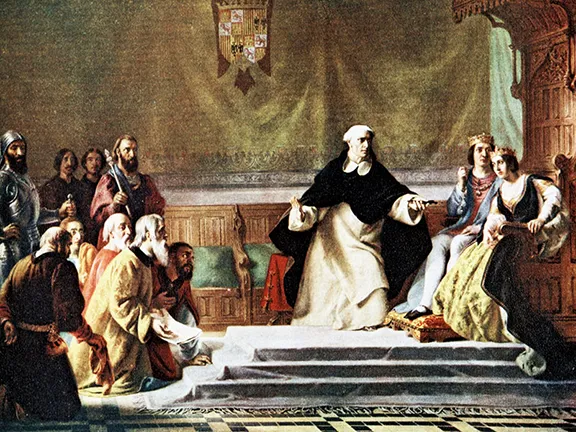The Early Years of the Spanish Inquisition persecuted conversos, not Jews although persecution of the Jews increased the numbers of conversos
By Nick Nutter | Updated 8 Mar 2022 | Andalucia | History |
Login to add to YOUR Favourites or Read Later


Torquemada offers monarchs 30 pieces of silver
The Spanish Inquisition was established in 1478 and the first two inquisitors were appointed in 1480. Within two years the Inquisition was causing concern in Rome for the corruption engendered by it. Could the 15th century spin doctors handle it?
On 27th September 1480, commissions as inquisitors were issued to two priests and one advisor at Medina del Campo. It had taken Ferdinand 2 years to arrive at the conclusion that an Inquisition was necessary and he now voiced his reasoning ‘We could do no less because we were told so many things about Andalucia.’ The real reason may be more political. The Inquisition first concerned itself with the southern parts of Castile as it was then, Seville and Córdoba. Isabella’s supporters in the civil wars of the 1470s had taken lucrative official posts in these cities pushing out the incumbents who were mainly conversos and supporters of the rebel nobles. They naturally resented their loss and formed a core of potential enemies.
The 15th century spin doctors got to work. A story was soon circulating involving a converso councillor, Diego de Susán. He was supposedly at the centre of a plot to overthrow the Inquisition and called a meeting of Seville dignitaries in 1480 who committed to raising money, men and arms for that purpose. Only the betrayal of the plot by the fermosa fembra (beautiful maiden) Susanna, daughter of Susán, fearing for the fate of her Christian lover, prevented an uprising. The story went on to relate how three of the richest leaders of the city were subsequently burnt alive. In fact there was no plot. Councillor Susán had died in 1479 and he had no daughter.
The first auto de fe was celebrated on the 6th February 1481 in Seville when six people were burnt at the stake. The sermon was preached by Fray Alonso de Hojeda. Within a few days he was dead, a victim of the plague. Perhaps if that had been seen as a sign from God the horrors to come would not have occurred.
During 1481 thousands of converso households took flight from Andalucia, in some areas depopulating the countryside. It was obvious that many did not trust the Inquisitors and the reason for that is not hard to find. Many accusations were made by malicious neighbours, converso, Jew and Old Christian alike. The identity of the accuser was not revealed to the defendant who was assumed guilty unless he could prove otherwise. There are many cases where the event allegedly proving heresy took place tens of years previously and may have been as innocent as changing the bed sheets on a Friday or nodding the head in the manner of a praying Jew. With such a legal opportunity to take revenge for slights imagined and real it is not surprising that the workload of the Inquisition increased.
In February 1482 seven more Inquisitors were appointed, one being the infamous Tomás de Torquemada.
Many chroniclers claim Tomás de Torquemada was a converso. The line is tenuous at best. His uncle, Juan de Torquemada had an ancestor, Álvar Fernández de Torquemada, who was married to a first-generation converso and Juan’s grandmother was also a converso. Perhaps to quash any rumours of himself being a converso, or to prevent himself being tarred with the same brush, Tomás Torquemada entered the local San Pablo Dominican monastery. He rapidly gained a reputation as a zealous advocate of church orthodoxy, learning, piety, and austerity. By 1469 he was Princess Isabella’s confessor and personal advisor, and it was he who advised her to marry Ferdinand of Aragon to consolidate their respective kingdoms. In 1474, Isabella was crowned Queen of Castile and Torquemada had his power base.
Torquemada deeply feared the Marranos (converts from Judaism who still practiced their faith in secret) and Moriscos (Muslims that had converted to Christianity) as a menace to Spain's welfare by both their increasing religious influence and their economic domination of Spain.
Word of the corruption engendered by the Inquisition reached Rome and in April 1482 Sixtus IV issued a bull in which he protested:
‘that in Aragon, Valencia, Mallorca and Catalonia the Inquisition has for some time been moved not by zeal for the faith and salvation of souls, but by lust for wealth and that many true and faithful Christians, on the testimony of enemies, rivals, slaves and other lower and even less proper persons have, without any legitimate proof, been thrust into secular prisons, tortured and condemned as relapsed heretics, deprived of their goods and property and handed over to the secular arm to be executed to the peril of souls, setting a pernicious example and causing disgust to many.’
Ferdinand was outraged and in public pretended to disbelieve the authenticity of the bull on the grounds that no sensible pontiff would issue such a document. He sent a strongly worded protest to Sixtus as a result of which the bull was suspended. Ferdinand now had total control of the Inquisition throughout Spain and her territories.
It is from this period that confusion arises as to the role of the Inquisition in the persecution of Jews. In fact the two policies, persecution of Jews and persecution of heretics, are separate although Torquemada undoubtedly acted as an advisor to the two monarchs on both subjects. The persecution of the Jews did, however, produce another crop of conversos, potential victims for the Inquisition.
Since the 1460’s Church leaders had been increasingly advocating a separation between Jews and conversos. They feared that conversos would be inveigled back into Judaism despite it having been against the law since 1255 for Christians to convert to Judaism or Islam.
In order to minimise the contact between Jews and conversos, a partial expulsion of Jews was ordered in Andalucia in 1482. This was initiated by the monarchs. The exiles were free to go to other parts of Spain. In 1483, Jews were ordered out of Seville, Córdoba and Cádiz but the crown delayed implementation until 1484 when only the Jews from Seville were expelled.
Even then this action may have been motivated more by a fear of Jewish collaboration with the Muslim kingdom of Granada. A few years later Jews were still living in Córdoba and Cádiz. A similar expulsion order was issued in Aragón in 1486. The order was ignored and eventually cancelled.
Even as late as 1490 Ferdinand and Isabella were actively protecting their Jews from excessive repression by nobles. However, over the next couple of years, Torquemada seems to have persuaded the monarchs that a total expulsion of Jews was the only policy to follow.
An edict of expulsion was issued on the 31st March 1492 by Ferdinand and Isabella from Granada and gave the Jews of Castile and Aragon until the 31st July to accept baptism or leave the country. It gave as its main justification for the edict, ‘the great harm suffered by Christians from the contact, intercourse and communication which they have with Jews, who always attempt in various ways to seduce faithful Christians from our Holy Catholic Faith’.
The general population had been prepared for the expulsion order by a series of stories of Jewish atrocities. The converso bishop of Segovia is reported to have punished sixteen Jews for a ritual murder of a Christian child. In a separate case in 1491 six conversos and six Jews were tortured at La Guardia in Toledo province. They confessed to taking a Christian child, crucifying him and cutting his heart out in an attempt to create a spell to rid Spain of Christians. The culprits were publicly executed at Avila in November that year. The affair was widely publicised.
Many Jews were baptised and welcomed into the Church yet, two months after the edict, Ferdinand felt obliged to inform Torquemada that,
‘many wish to become Christians but are afraid to do so because of the Inquisition. Accordingly you will write to the Inquisitors, ordering them that even if something is proved against those persons who become Christians after the decree of expulsion, no steps be taken against them, at least for small matters’.
Just before July 1492 it is calculated from tax records that there may have been as many as 80,000 Jews expelled from Spain. There are no contemporary statistics, the first historian to write about the event did so one hundred years later. These early histories put the figure for expulsions much higher, as many as 800,000. Even so, those expelled suffered greatly, particularly the poor. They were often helped by richer relatives, some of whom were conversos. Some richer Jews, since they could not take their wealth with them, transferred their property to converso relatives. Some bribed officials to allow them to take gold and jewellery with them. There are accounts of Jewish houses being sold for a mule but, rich or poor, they all suffered on their journeys.
The ships that were to transport them out of Spain were old, leaky and badly managed. Many set sail, only to return at the first storm, forcing the passengers to accept baptism to remain in Spain. Many more made it to North Africa where they were pillaged and murdered. Yet more returned to Spain by land from Portugal. When they returned and converted, the new conversos were entitled to have their property returned at the same price at which it had been purchased and they could return to their old jobs. Many Jews were actively welcomed back like the Jewish doctors who returned to Madrid as Christians in 1494. Those who returned and suffered as a result of local anti Semitism found themselves protected by the monarchs who issued a number of protectionist decrees.
It is therefore unclear just what had been achieved by the expulsion order. Even amongst the Christians in Spain there was criticism. The inquisitor Jeronimo de Zurita tells us at the time that,
‘many were of the opinion that the king was making a mistake’.
A hundred years later the inquisitor Luis de Paramo, writing the first history of the Inquisition writes,
‘I cannot omit to mention that there were learned men who did not feel that the edict was justified.’
It appears that the only man to express a strong opinion for, and totally support the edict was Torquemada himself. A deputation of Jews in 1492 offered Ferdinand a large sum of money to reconsider his decision. Torquemada burst into the room and flung thirty pieces of silver on the table and demanded to know, ‘for what price Christ was again to be sold to the Jews’.